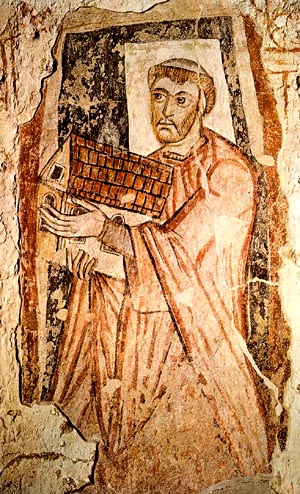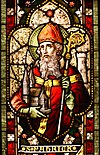
Benedict Biscop, also known as Biscop Baducing, was an Anglo-Saxon abbot and founder of Monkwearmouth-Jarrow Priory and was considered a saint after his death.
The Culdees were members of ascetic Christian monastic and eremitical communities of Ireland, Scotland, Wales and England in the Middle Ages. Appearing first in Ireland and then in Scotland, subsequently attached to cathedral or collegiate churches; they lived in monastic fashion though not taking monastic vows.
Óengus mac Óengobann, better known as Saint Óengus of Tallaght or Óengus the Culdee, was an Irish bishop, reformer and writer, who flourished in the first quarter of the 9th century and is held to be the author of the Félire Óengusso and possibly the Martyrology of Tallaght.
Gerald of Mayo is a saint of the Roman Catholic Church and Eastern Orthodox Church.

Bangor Abbey was established by Saint Comgall in 558 in Bangor, County Down, Northern Ireland and was famous for its learning and austere rule. It is not to be confused with the slightly older abbey in Wales on the site of Bangor Cathedral.

Iarlaithe mac Loga, also known as Jarlath, was an Irish priest and scholar from Connacht, remembered as the founder of the monastic School of Tuam and of the Archdiocese of Tuam, of which he is the patron saint. No medieval Life for Jarlath is extant, but sources for his life and cult include genealogies, martyrologies, the Irish Lives of St Brendan of Clonfert, and a biography compiled by John Colgan in the 17th century.
Saint Mochta, was the last surviving disciple of Saint Patrick.

Ciarán of Saigir, also known as Ciarán mac Luaigne or Saint Kieran, was one of the Twelve Apostles of Ireland and is considered the first saint to have been born in Ireland, although the legend that he preceded Saint Patrick is questionable. Ciarán was bishop of Saighir (Seir-Kieran) and remains the patron saint of its successor, the diocese of Ossory.

Assicus(Asicus, Assic) was the first bishop of Elphin, Ireland, and venerated as the patron saint of that place. He was also an artisan metalworker.

Secundinus, or Sechnall as he was known in Irish, was founder and patron saint of Domhnach Sechnaill, County Meath, who went down in medieval tradition as a disciple of St Patrick and one of the first bishops of Armagh. Historians have suggested, however, that the connection with St Patrick was a later tradition invented by Armagh historians in favour of their patron saint and that Secundinus is more likely to have been a separate missionary, possibly a companion of Palladius.

Saint Patrick was a fifth-century Romano-British Christian missionary and bishop in Ireland. Known as the "Apostle of Ireland", he is the primary patron saint of Ireland, the other patron saints being Brigid of Kildare and Columba. Patrick was never formally canonised, having lived before the current laws of the Catholic Church in these matters. Nevertheless, he is venerated as a saint in the Catholic Church, the Lutheran Church, the Church of Ireland, and in the Eastern Orthodox Church, where he is regarded as equal-to-the-apostles and Enlightener of Ireland.
St. Ruadán mac Fergusa Birn, also known Rowan, Ruadon, Roadan, Ruadhán, Rodon and Rodan, was an Irish Christian abbot who founded the monastery of Lorrha, near Terryglass. He was known for his prophesies. After his death, he was venerated as a saint and as one of the "Twelve Apostles of Ireland". His feast day is 15 April.
Saint Iserninus was an early Christian missionary of Ireland who is associated with Saint Patrick and Saint Auxilius in establishing Christianity in the south of that island. More recent research associates him not with Patrick but with Palladius.
Saint Auxilius, or Usaille, was an early Christian missionary of Ireland who is associated with Saint Patrick, Saint Seachnaill (Secundinus), and Saint Iserninus in establishing Christianity in the south of that island, although more recent studies tend to associate him with the earlier Palladius.
Events from the 5th century in Ireland.
Saint Kerrill aka Caireall mac Curnain was a Christian missionary in what is now east County Galway, alive in the mid-to-late 5th century.
Dubthach maccu Lugair, is a legendary Irish poet and lawyer who supposedly lived at the time of St Patrick's mission in Ireland and in the reign of Lóegaire mac Néill, high-king of Ireland, to which Dubthach served as Chief Poet and Brehon. In contrast to the king and his druids, he is said to have readily accepted the new religion. This event has played a major part in Hiberno-Latin and Irish sources as representing the integration of native Irish learning with the Christian faith.

November 8 - Eastern Orthodox liturgical calendar - November 10
Saint Fiachra was the Bishop of Armagh, Ireland from 548 to 558.

Kilbennen or Kilbannon is a medieval ecclesiastical site and National Monument located in County Galway, Ireland.











